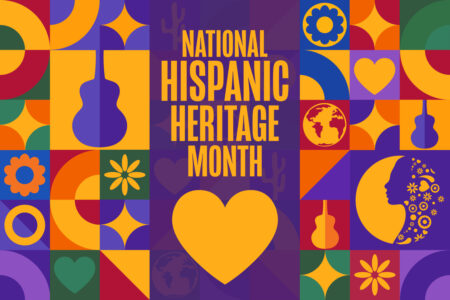
Share On Social!
How important is the 2020 Census?
Well, the results will determine political power, representation in Congress, and funding for schools, hospitals, roads, and social services in your community for the next 10 years.
Here are some Q&As that emphasize the need to count Latinos and all people!
Supreme Court Update, October 15, 2020: The Supreme Court ruled on Oct. 13, that Trump administration can end census field operations early despite delays and difficulties related to the ongoing pandemic.
- Internet self-response will be available through 11:59 p.m. Hawaii Standard Time (HST) Oct. 15 (5:59 a.m. Eastern Daylight Time on Oct. 16).
- Paper responses must be postmarked by Oct. 15, 2020.
Coronavirus Update, July 7, 2020: Learn how the Census Bureau is pushing forward amid the ongoing pandemic.
Coronavirus Update, April 20, 2020: The Census has officially started with options to complete the 12-question form by mail, phone, or online. “The bureau also said it would extend the deadline for collecting census data, now Aug. 15, to Oct. 31, and would begin reopening its field offices — which have been shuttered since mid-March — sometime after June 1,” according to The New York Times.
1. Why Is There a Census?
The U.S. Constitution requires the government count everyone living in the country regardless of race, ethnicity, or citizenship status.
The Census Act of 1790 created the first census.
The government has conducted it every 10 years since to determine a population count, not a citizenship count.
“The data collected affect our nation’s ability to ensure equal representation and equal access to important governmental and private sector resources for all Americans, including across racial and ethnic lines,” according to the Leadership Conference Education Fund.
2. When Does the Census Officially Start?
Census Day is April 1, 2020.
Most households can start participating around mid-March, when letters with instructions are scheduled to be mailed to 95% of homes around the country, NPR reports.

3. What Does the Census Questionnaire Ask?
One person in each household is required by law to complete the census questionnaire.
The questionnaire has seven questions that take about 10 minutes to answer:
- Name
- Gender
- Age
- Date of birth
- Hispanic origin
- Race
- Relationship to the person completing the questionnaire
The 2020 Census will not include a citizenship question. Moreover, the census doesn’t include questions about religious beliefs or membership in a religious body. 4. How Can You Fill Out the Census Questionnaire?
You can answer the questionnaire by mail, phone, or, for the first time ever, online.
4. What If You Don’t Fill Out the Census Questionnaire?
You can be fined for refusing to answer a census question or intentionally giving a false answer. But the penalty is rarely enforced.
If you submit an incomplete census form you will still be counted.
In May 2020, the Census will begin following up door-to-door to homes that haven’t responded.
These door-to-door workers are often community members trying to help their neighbors. They will never ask for Social Security numbers, bank or credit card information, donations, or anything on behalf of a political party.
Coronavirus Update on April 2, 2020: The Census Bureau has suspended all in-person census surveys until further notice. They stalled field operations until at least April 15.
5. How Private Are Your Census Answers?
You Census answers remain anonymous and protected under Title 13 of the U.S. Code.
Personal privacy also is protected by the “72-Year Rule,” according to the National Conference of State Legislators (NCSL).
“The government is not allowed to release personal data on individuals for 72 years,” according to the NCSL. “That means census data on individuals from the 1940 census only became available in April 2012.”
6. Who Uses Census Data and for What?
Here are a few way groups use Census data, according to the Census Bureau:
- Residents use the census to support community initiatives involving legislation, quality-of-life, and consumer advocacy.
- Real estate developers use the census to build new homes and revitalize old neighborhoods.
- Businesses use census data to decide where to build offices and stores, which create jobs.
- Local governments use the census for public safety and emergency preparedness.
- The U.S. government uses census data to reapportion the House of Representatives, determining how many seats each state gets.
- The U.S. government also uses census data to distribute billions in federal funds, grants, and support to states, counties, and communities.
“Facts accumulated by the census are used not only by the government at all levels—they are used by businesses, non-profits and policymakers, too,” according to the NCSL.
7. Are Census Counts Accurate When It Comes to Latinos?
The Census often undercounts certain hard-to-reach populations. These include rural communities, communities of color, immigrants, young children and low- income people.
Latinos are frequently undercounted.
For example, in 2010, the net undercount rate for young Latinos was 7.1%, compared to 4.3% for non-Latinos. More than 400,000 Latino children under age four were left uncounted in the 2010 Census.
8. Why Does the Census Undercount Latinos?
Several characteristics are associated with a Latino undercount, according to the Leadership Conference Education Fund:
- Language barriers, poverty, and low educational attainment require special attention, making the Latino community hard to count.
- Concerns about data confidentiality, due to negative political rhetoric and federal detention, reduce participation in the census among immigrant communities.
- Latino children often live in a household with complex living arrangements in addition to other characteristics that increase risk of being hard-to-count.
Whatever the reasons, an undercount of Latinos has a negative impact on the representation and health of the Latino community.
Coronavirus Update on April 2, 2020: Census advocates are changing their canvassing strategies to reach historically undercounted populations during the global pandemic.
“Instead of door-to-door leafleting or tabling, they’re phone banking and putting up fliers at essential locations still open during nationwide quarantines, like supermarkets. They’re also focusing on online outreach, with online happy hours, zoom conferences, posts in Facebook groups, and live streams or video chats,” according to Saher Khan with PBS News Hour.
For example, “in Pennsylvania’s Lehigh Valley, a campaign is targeting Hispanic households that are traditionally hard to count by inserting Spanish-language ads in Facebook videos that are reached via Spanish internet addresses,” according to Michael Wines with the New York Times.
9. How Does Census Data Impact Latinos and Political Representation?
U.S. Census Bureau data helps states determine where populations have risen or fallen.
This helps adjust congressional district lines so each district has as equal in population to all other congressional districts in a state as possible.
Congressional districts for the 113th through 116th sessions, for example, were established by the states based on the result of the 2010 Census.
Fair and equitable distribution of political power is critical for Latinos and all Americans to have a voice in decisions that affect their lives.
Coronavirus Update on April 2, 2020: On March 25, six Latinx state legislators from Arizona, Colorado, Florida, and Texas discussed opportunities and challenges for the upcoming census in a Zoom meeting. You can watch it here.
10. How Does Census Data Impact Latinos and Social Support?
The government uses census data also to distribute more than $800 billion in annual funding to states, counties, cities, and households.
Roughly 300 federal assistance programs receive census-guided funding, including:
- Medical Assistance Program (Medicaid)
- Supplemental Nutrition Assistance Program (SNAP)
- Highway Planning and Construction
- Section 8 Housing Choice Vouchers
- Title I Grants to Local Education Agencies
- National School Lunch Program
- Head Start/Early Head Start
- Supplemental Nutrition Program for Women, Infants, and Children (WIC)
Fair and equitable distribution of funding is particularly critical for Latinos and all Americans who have been disproportionately burdened by discriminatory policies and practices.
11. What Would a Latino Census Undercount Really Mean?
An undercount during this once-a-decade Census count means less representation in Congress and less money per year for assistance programs like Medicaid, child and foster care, and Head Start.
For example:
- If 3% of Latinos are undercounted, Florida could lose $131 million for Medicaid (children only). The state could lose $525 million for children-only Medicaid if 12% of Latinos are undercounted.
- Texas could lose between $9.8 million to $39.4 million for the Children’s Health Insurance Program (CHIP) for a 3% to 12% undercount of Latinos.
- Texas could also lose up to $14 billion of federal money for housing, child and foster care, and other family aid programs.
- Colorado could lose $712,470 to $2.8 million in funding for Title IV-E Foster Care if 3% to 12% of Latinos are undercounted.
- Arizona could lose $648,300 to $2.5 million in funding for Child Care and Development Block Grants (CCDBG) for a 3% to 12% undercount of Latinos.
When Latinos are undercounted, it denies them a full voice in policy decision-making and support.
Even counting Latino children is important.
“If young Latino children are not counted in #Census2020, the right amount of funding won’t reach schools, hospitals, daycare centers, and other programs that support healthy families,” according to a new video in English and Spanish from the National Association of Latino Elected and Appointed Officials (NALEO) shared via Twitter. “Count all kids! #HazmeContar”
12. Should Latinos Be Afraid to Partake in the Census?
No.
Sadly, due to confusion, distrust, and fears over racism and immigration status, many Latinos are expected to be left out of the 2020 Census.
Some estimates suggest the Latino undercount could be up to 12%, according to Child Trends.
But Latinos do not have to be afraid to fill out the Census questionnaire.
The 2020 Census will not include a citizenship question.
Moreover, your answers are confidential.
By law, the Census Bureau cannot release any identifiable information about you, your home, or your business.
13. How Can You Get Involved in the Census (and Make Money)?
The U.S. Census Bureau is recruiting thousands of people across the country for temporary jobs.
The Bureau hired more than 600,000 individuals to go door-to-door and follow up with roughly 50 million households that did not respond to the 2010 census.
Coronavirus Update on April 2, 2020: Although there is a temporary hiring freeze, the Census Bureau still plans on hiring 500,000 workers.
This is your chance to play a part in history and ensure everyone in your community is counted.
14. What Else Should You Do Regarding the Census?
Coronavirus Update on April 2, 2020: The Census Bureau has extended the final deadline for finishing the count by two weeks, to mid-August 2020.
Do you part to make sure you and your family gets counted.
Then help spread the word in your community by sharing this post on social media!
You can also follow and join the ¡Hágase Contar! Census 2020 campaign.
They provide partners with trainings, briefings, promotional information, public awareness events, and a communications toolkit with sample social media posts and graphics.
You can also get a Health Equity Report Card to see how your county is doing on critical social and economic factors to help you build the case for critical census-guided financial assistance.
By The Numbers
44
million
immigrants live in the United States



